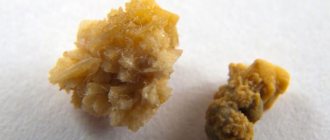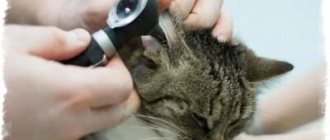Bad-smelling blood discharge from the cat’s genitals indicates the progression of diseases in the body, the causes of which are important to find out and eliminate as soon as possible. However, fluid from a cat’s vagina often appears as a result of natural physiological processes, for example, during estrus, before giving birth. In this situation, the discharge is transparent or light, without an unpleasant odor or other pathological inclusions.
Types and causes of occurrence
Physiological
When cats come into heat, a secretion is naturally released from the vagina, which is a signal indicating to the male that the female is ready to mate. Secretion can be observed within 2-3 days. During this period, the cat is especially affectionate, constantly rubbing against its legs, raising the back of its body, and arching its back. In this case, the secretion is released absolutely transparent, and any unpleasant odor is completely absent.
Discharge from the loop in cats can be observed during pregnancy, or more precisely, by the end of 3 weeks. During this period, a mucous plug forms in the cervix, which sometimes flows from the uterus, but its discharge is not abundant. At week 6, white or yellow discharge may appear from the vaginal passage. This is amniotic fluid leaking - a sign of impending labor. 2-3 days before the kittens are born, yellow or green mucus leaks out. This clot is a plug that, for natural reasons, is rejected immediately before childbirth.
During contractions, pink or red discharge appears. Brown clots are also normal. 2-3 weeks after lambing, cats may still have bleeding. In addition, yellowish and green inclusions are also acceptable, but their smell should not be unpleasant. During this period, it is important for the owner to constantly monitor the pet, especially if it is the first pregnancy.
Pus and blood from the vagina at any stage of pregnancy are a dangerous symptom, indicating pathology and the onset of inflammation. If the inflammatory process is not eliminated in a timely manner, the animal will die.
Pathological
Excessive bleeding in a cat indicates the development of the disease, so you should immediately consult a doctor.
Severe bleeding from a sterilized cat with the smell of rot can be a symptom of the progression of cancer localized in the kidney tissues or mammary glands. In this case, sexual activity may occur after sterilization, so the owner must urgently show the pet to a doctor. Bleeding and purulent vaginal discharge are often observed with the following diseases:
- Vaginitis. Inflammation of the vaginal walls, occurring in acute and chronic forms. The discharge is white at the initial stage, then it turns yellow. Brown clots indicate a bacterial infection.
- Pyometra. Inflammation of the uterus, which occurs in both young and old cats. The animal is bothered by heavy bleeding, and the inclusions may be red or brown, which in the latter case indicates an advanced process.
- Hematometra. With this disease, blood discharge is scanty. The main cause of the pathology is congenital anomalies, uterine fibroids, interrupted pregnancy, pathological or too frequent childbirth.
- Endometritis. Inflammation of the uterine wall, which often occurs after a difficult birth, accompanied by a delay in the release of the placenta. The result of such a deviation is infection of the organ, the development of complications and bleeding as a result.
- Urethritis. Inflammation of the urethra. With this disease, discharge from the urethra is observed in a cat or cat. If the disease is advanced, bloody and purulent inclusions with an unpleasant odor appear in the urine.
Dangerous symptoms
If a cat’s blood is released from the vagina in clots due to the progression of dangerous disorders in the body, the following pathological symptoms will be additionally disturbing:
- decreased animal activity;
- loss of appetite or complete refusal of food and water;
- frequent or infrequent painful urination with blood;
- thorough licking of the anterior passage;
- increased body temperature;
- tachycardia, breathing problems.
Acute urethritis in a cat is accompanied by severe polyuria and irrepressible thirst. If the owner notices that blood or purulent fluid is flowing from under the tail, this symptom indicates the development of complications that cannot be dealt with without medical help.
A cat's eyes are festering - how to treat it?
White discharge from the eyes, as well as watery and clear discharge, usually indicates an allergic reaction. Suitable eye drops, rinsing with solutions and using ointments will help you overcome it. It is imperative to determine the cause of the allergy, because without eliminating the original source of the disease, there is no point in dealing with the symptoms. If you notice bloody discharge, then this may indicate the presence of an infection in the pet’s body, or a violation of the patency of the tear ducts. In both cases, only veterinarian advice and a thorough examination will help. Home treatment without prior consultation with a specialist is highly not recommended.
Black discharge from the eyes occurs with infections, chlamydia and herpesvirus. Sometimes they occur due to ordinary injuries and have a shade close to brown. These discharges themselves are extremely dangerous, because apart from them there may be no symptoms. In any case, you need to visit a specialist for an examination and a course of treatment. Most often, antibacterial eye drops, solutions of chamomile infusion or strong tea are used. Rinsing with warm water will also work. Black discharge is removed with saline solution.
Since there are many reasons for the appearance of discharge from the eyes in cats, it is better not to do home treatment without visiting a doctor.
Trust the professionals and give your pet a long and happy life. An experienced veterinarian will not only determine the source of the disease and prescribe an appropriate course of treatment, but will also share with you valuable recommendations to prevent similar problems in the future. Your cat will certainly appreciate such a reverent attitude and will be grateful for the attention, care and kindness. Addresses of clinics Make an appointment with a doctor Prices
Diagnostic methods
Diagnostic procedures include ultrasound examination of the abdominal organs.
If the bloody discharge in a young cat has a suspicious appearance and smells unpleasant, or if ichor with purulent inclusions leaks from the vagina, you should not hesitate to visit the doctor, otherwise complications cannot be avoided. At the initial appointment, the doctor will examine the animal, palpate the abdominal cavity, ask the owner about accompanying pathological symptoms, and also collect the necessary data that will help to understand why the animal is bleeding from the genitals.
The following diagnostic methods will help to establish an accurate diagnosis:
- general clinical analysis of blood and urine;
- biochemistry;
- microbiological study of a smear from the vagina and urethra;
- Ultrasound of the abdominal organs;
- radiography.
How to wash a cat's eyes at home?
Suitable herbal infusions of chamomile, oak bark, and saline solution will help your cat cope with the disease before being examined by a doctor. You can also wash her eyes with an alcohol-free antiseptic solution.
You need to wash your cat's eyes with a cotton swab, from the outer edge to the inner. This must be done very carefully and gently so as not to harm the pet and cause him a minimum of discomfort.
Discharge from the eyes and nose is also treated with special ointments. In some cases, the cat needs to pull back the lower eyelid and put ointment there, for example, tetracycline ointment, novocaine, hydrocartisone drops, levomecitin drops. Keep in mind that it is not recommended to use antibiotics and ointments on your own without a veterinarian's prescription.
How to treat pathology?
When brown, pink or white discharge appears in a cat due to natural causes, no special treatment is prescribed. If the owner does not intend to breed offspring, it is better to sterilize the pet. In a castrated cat, such problems disappear on their own. It’s another matter when blood flows from the genitals due to the progression of a dangerous disease. A treatment regimen that includes the following groups of drugs will help stop the disease:
An examination will help to cope with the situation, on the basis of which drug treatment will be prescribed.
- Hemostatic. Prescribed only by a doctor, they are used in cases where bleeding occurs without stopping due to a violation of the hematopoietic process.
- Antibiotics. They are used when there is pus with pathological ichor in the vaginal discharge, which indicates the addition of a bacterial infection.
Sometimes, with heavy bleeding, conservative therapy is powerless. Then the doctor decides to treat the pathology surgically. During surgery, defects that bleed are eliminated, as well as affected internal organs, including the uterus, are removed. After the operation, rehabilitation is carried out. Fluid may still be released from the genitals, so the animal must be under the supervision of a doctor who strictly monitors how recovery is progressing.
Causes of discharge
Overall, when it comes to the problem of "cat leaking brown fluid", there are several suspects, but anal sac disease is at the top of the list.
FYI: If you lift a cat's tail, you will see two anal glands located slightly below the anus on either side. Because the glands are embedded in muscles, they are difficult to see from afar. In either case, the role of the anal glands is to secrete a yellow-brown fluid when the cat defecates. As you might expect, the smell of liquids is far from pleasant, but cats rely on liquids to mark their territory.
© shutterstock
Usually, a cat's anal glands work as intended, but sometimes something can cause them to produce a thicker-than-normal fluid. Because the pores on the glands cannot drain fluid sufficiently, the glands become larger and larger. After some time, cats will understand what is happening and will try to manually get rid of the fluid in the glands by licking, tugging, ...
If pets can successfully empty their congested anal glands, then everything is fine. On the other hand, if pets can't do anything on their own, people need to step in.
What happens if an owner ignores their cat's plight? Well, pets suffering from anal sac disorder experience severe discomfort that is a direct result of the strange activity of the anal glands. Moreover, when affected cats lick their butts over and over again to cause discharge, they introduce bacteria from their mouth to the area. This means that the risk of urinary tract infection increases dramatically. Finally, the glands may one day burst, causing severe pain, infection and possibly death.
Prevention
If fluid drips from the organs of the genitourinary system for physiological reasons, but the animal is not planned to be mated, it is better to sterilize it to avoid pathological complications associated with hormonal surges. When a cat has a history of inflammatory and other diseases of the urinary system, it is recommended to periodically visit a veterinarian, do a preventive ultrasound, promptly treat internal diseases, do routine vaccinations, and if pathological symptoms develop, do not self-medicate, but find out the diagnosis as soon as possible and begin treatment. therapy under the supervision of a physician.
What to do
- Swollen glands
In cats with swollen glands, veterinarians first drain fluid with a syringe, clean out the glands, and then administer antibiotics to treat infections. In most cases, your pet can go away after this, but if your cat has chronic swelling, surgical removal of the glands is highly recommended.
In case your cat has strange openings in the anal sac, veterinarians may be able to formulate a treatment regimen based on cyclosporine. Simply put, cyclosporine prevents bacterial infections and is taken orally.
Reminder : Cyclosporine is known to weaken the immune system and, as a result, long-term use of this drug is not recommended. In most cases, it is better to remove the pet's glands instead of controlling the tumor with cyclosporine. Spaying your pet is also a good idea to limit the activity of the anal glands and reduce the frequency of episodes of swelling.
- Torn glands
At this point there is nothing left to do but perform emergency surgery, the vets will remove whatever is left of the glands and clean the area. If the entire operation goes smoothly, the risk of infection should be minimal and a recovery phase will follow. For 1-2 weeks you will need to give your pet an antibiotic prescribed by your veterinarian, but that's it, your pet will be back to his normal self before you know it. As always, return to the clinic periodically to have stitches, staples, etc. removed.











